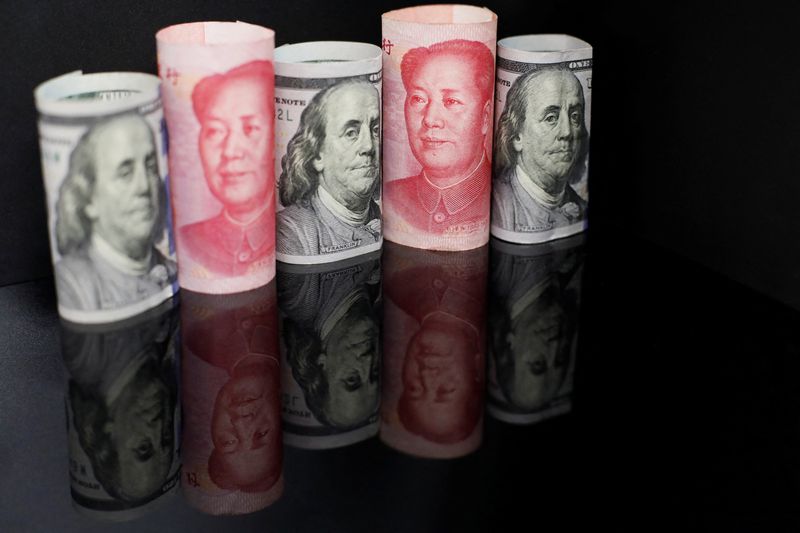Forex
Dollar sinks as inflation, jobless claims data cement Sept Fed pause


© Reuters. FILE PHOTO: Banknotes of Chinese yuan and U.S. dollar are seen in this illustration picture taken September 29, 2022. REUTERS/Florence Lo/Illustration
By Gertrude Chavez-Dreyfuss
NEW YORK (Reuters) – The dollar fell on Thursday after data showed U.S. consumer prices rose modestly last month, while initial jobless claims gained in the latest week, reinforcing expectations the Federal Reserve will pause interest rate hikes at the next policy meeting.
The consumer price index (CPI) rose 0.2% last month, matching the gain in June, the Labor Department said on Thursday. The CPI climbed 3.2% in the 12 months through July, up from a 3.0% rise in June, which was the smallest year-on-year gain since March 2021.
Excluding the volatile food and energy categories, the CPI gained 0.2% in July, the same as the increase in June. In the 12 months through July, core CPI grew 4.7% after rising 4.8% in June.
“Despite the annualised headline CPI rate re-accelerating slightly in July, the gentle 0.2% monthly acceleration for both core and headline CPI should soothe markets and the Fed,” said Nathaniel Casey, investment strategist at wealth management firm Evelyn Partners.
“There is still one more inflation and job report to come before the next FOMC meeting on the 20th of September, so while committee members are unlikely to make their next decision from this CPI print alone, it is yet another step in the right direction.”
Futures on the benchmark fed funds rate have priced in a pause in rate hikes at the next meeting and for the rest of the year. The next possible move by the Fed is a rate cut in May 2024, rate futures showed.
A separate report from the Labor Department on Thursday showed initial claims for state unemployment benefits increased 21,000 to a seasonally adjusted 248,000 for the week ended Aug. 5. Economists had forecast 230,000 claims for the latest week.
The was last down 0.5% at 102.01, while the euro rose 0.6% to $1.1040.
The greenback also fell versus the Swiss franc, down 0.5% at 0.8730 francs.
The yen, however, was a different story, slumping against major currencies.
Against the yen, the dollar hit a five-week high and was last up 0.3% at 144.205. The euro soared against the yen, hitting its strongest level since August 2008. It was last up 0.8% at 159.06 yen.
Analysts had partly attributed the yen’s weak trend to higher oil prices, given that Japan is a major oil importer.
“The fact that energy prices have risen for almost seven weeks, that’s certainly weighed on the yen,” said Tony Sycamore, a market analyst at IG. A break above 145 would open the way potentially to 148, he added.
========================================================
Currency bid prices at 10:03AM (1403 GMT)
Description RIC Last U.S. Close Pct Change YTD Pct High Bid Low Bid
Previous Change
Session
Dollar index 102.0200 102.4800 -0.43% -1.420% +102.5600 +101.7600
Euro/Dollar $1.1040 $1.0975 +0.58% +3.02% +$1.1065 +$1.0968
Dollar/Yen 144.1000 143.7500 +0.26% +9.93% +144.2750 +143.2550
Euro/Yen 159.09 157.73 +0.86% +13.39% +159.2000 +157.6700
Dollar/Swiss 0.8721 0.8773 -0.58% -5.67% +0.8776 +0.8690
Sterling/Dollar $1.2770 $1.2721 +0.36% +5.56% +$1.2818 +$1.2708
Dollar/Canadian 1.3377 1.3420 -0.31% -1.26% +1.3425 +1.3373
Aussie/Dollar $0.6585 $0.6529 +0.83% -3.43% +$0.6617 +$0.6528
Euro/Swiss 0.9626 0.9625 +0.01% -2.72% +0.9637 +0.9615
Euro/Sterling 0.8643 0.8625 +0.21% -2.27% +0.8646 +0.8626
NZ $0.6088 $0.6052 +0.61% -4.10% +$0.6117 +$0.6051
Dollar/Dollar
Dollar/Norway 10.1440 10.2080 -0.51% +3.48% +10.2300 +10.0900
Euro/Norway 11.2007 11.1970 +0.03% +6.74% +11.2506 +11.1587
Dollar/Sweden 10.5709 10.6654 -0.30% +1.57% +10.6803 +10.5459
Euro/Sweden 11.6709 11.7063 -0.30% +4.68% +11.7405 +11.6679

 Forex3 years ago
Forex3 years agoForex Today: the dollar is gaining strength amid gloomy sentiment at the start of the Fed’s week

 Forex3 years ago
Forex3 years agoUnbiased review of Pocket Option broker

 Forex3 years ago
Forex3 years agoDollar to pound sterling exchange rate today: Pound plummeted to its lowest since 1985

 Forex3 years ago
Forex3 years agoHow is the Australian dollar doing today?

 Cryptocurrency3 years ago
Cryptocurrency3 years agoWhat happened in the crypto market – current events today

 World3 years ago
World3 years agoWhy are modern video games an art form?

 Commodities3 years ago
Commodities3 years agoCopper continues to fall in price on expectations of lower demand in China

 Economy3 years ago
Economy3 years agoCrude oil tankers double in price due to EU anti-Russian sanctions





















